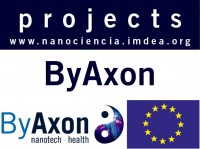ByAXON Towards an active bypass for neural reconnection
Prof. Rodolfo Miranda (PI), Dr. Teresa Gonzalez (PI)
-
Funding :
H2020-FETOPEN-2016-2017 no 737116
-
Duration: 2017 - 2020
The ByAxon consortium is composed of six partners from different areas of expertise. It is co-ordinated by M. Teresa González and Rodolfo Miranda at IMDEA Nanociencia, Spain, with the participation of Laura Ballerini at SISSA, Italy, Laurence Méchin at GREY-CNRS, France, M. Concepción Serrano at ICMM-CSIC, Spain, Elisa López-Dolado at Hospital Nacional de Paraplejicos de Toledo – SESCAM, Spain and Bernd Lecher at mfd Diagnostics GmbH, Germany.
ByAxon project is devoted to the development of a new generation of sensors and electrodes based on nanotechnology materials for neural interfacing. We aim to design and build a prototype of an active implant that could work directly at the spinal cord (SC) level. This implant will be primary focused on restoring the transmission of electrical signals in the injured SC, acting as an bi-directional local bypass, something not possible with current technology.
Current neural interfacing approaches are based on detecting and/or triggering electric potentials mainly at the brain level, in order to diagnose or treat different neurological disorders. In spite of many newly proposed innovations to use more biocompatible and flexible support materials, or to use smaller and more densely packed electrode microarrays, the sensing/triggering active part of these devices is still always a rigid metallic plate, which in most of the applications needs to be in close contact with the neural tissue. These tend to produce scars and reactions in the tissue, which complicates the correct performance of long-term implants. The ultimate non-contact sensing magnetoencephalography devices detect magnetic-field pulses generated by potentials at the brain, but require cryogenic temperatures, and are restricted to diagnose applications in specialized medical centres. Present electrodes are also being used to develope new brain-machine interfaces, which employ electrical potentials read at a person’s brain to activate a response of a computer or robot. These devices can be a huge help for paralyzed patients due to spinal cord injuries (SCI). They can even be used in combination with functional electrical stimulation. In this case, the computer uses the received signals to trigger new electrical potentials and motion directly at paralyzed limbs. Recent proposals of such SCI bypasses are highly impressive. Still, there is of course much work to do in the field. Important present drawbacks are the large number of cables and electrodes they require and, specially, the lack of sensory feedback.
http://www.byaxon-project.eu/




